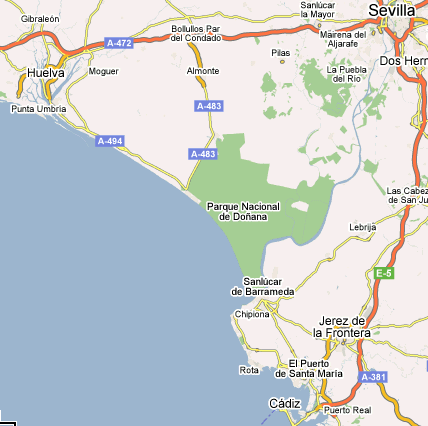George Bonsor
Huelva
Huelva is a city in southwest Spain that has frequently featured in the search for Tartessos. Adolph Schulten(a) as well as Jorge Bonsor devoted years to studying Huelva, Cádiz and Seville in their search for the legendary city. Even if Tartessos is conclusively identified, it is still a long way from proving it to be Plato’s Atlantis, which after all is supposed to be submerged. I was recently offered satellite images that purported to show traces of ground features that ‘might’ indicate ancient ruins with a remote possibility that they might be part of Tartessos!
(a) https://www.uv.es/~alabau/situacion.htm (Sp) (link broken Mar 2019 See: https://web.archive.org/web/20161217151230/https://www.uv.es/~alabau/situacion.htm
Doñana Marshes *
 The Doñana Marshes, a National Park in the valley of the Andalusian Guadalquivir River was linked with Atlantis over 400 years ago by José Pellicer. During the 1920’s George Bonsor and Adolph Schulten searched the area for evidence of Tartessos. After that interest in the marshes waned until a few years ago when Werner Wickboldt identified circular and rectangular features in the Park from satellite images, which he claimed a possibly Atlantean.
The Doñana Marshes, a National Park in the valley of the Andalusian Guadalquivir River was linked with Atlantis over 400 years ago by José Pellicer. During the 1920’s George Bonsor and Adolph Schulten searched the area for evidence of Tartessos. After that interest in the marshes waned until a few years ago when Werner Wickboldt identified circular and rectangular features in the Park from satellite images, which he claimed a possibly Atlantean.
Richard Freund, a professor from the University of Hartford, claims to have led a team to study the area and has had work included in a March 2011 National Geographic documentary, Finding Atlantis. However, Spanish anthropologist Juan Villarias-Robles who has worked on the site for some years has declared(a) that Freund did not lead the investigations on the site and in fact spent less than a week there. Wickboldt’s images turned out to be either smaller than expected or were from the Muslim period. Evidence for Tartessos or Atlantis has not been found.
(a) Muddying up Atlantis – Roger Catlin | TV Eye (archive.org) or see Archive 2122*
Blázquez y Delgado-Aguilera, Antonio
 Antonio Blázquez y Delgado–Aguilera (1859-1950) was a Spanish historian and geographer, >who, in 1923, edited Avienus’ Ora Maritima, which< identified Tartessos as having been located near the mouth of the Spanish Guadalquivir River, a year before Adolf Schulten published his book on the subject. He was a friend of George Bonsor who also sought Tartessos in the Doñana Marshes.
Antonio Blázquez y Delgado–Aguilera (1859-1950) was a Spanish historian and geographer, >who, in 1923, edited Avienus’ Ora Maritima, which< identified Tartessos as having been located near the mouth of the Spanish Guadalquivir River, a year before Adolf Schulten published his book on the subject. He was a friend of George Bonsor who also sought Tartessos in the Doñana Marshes.
